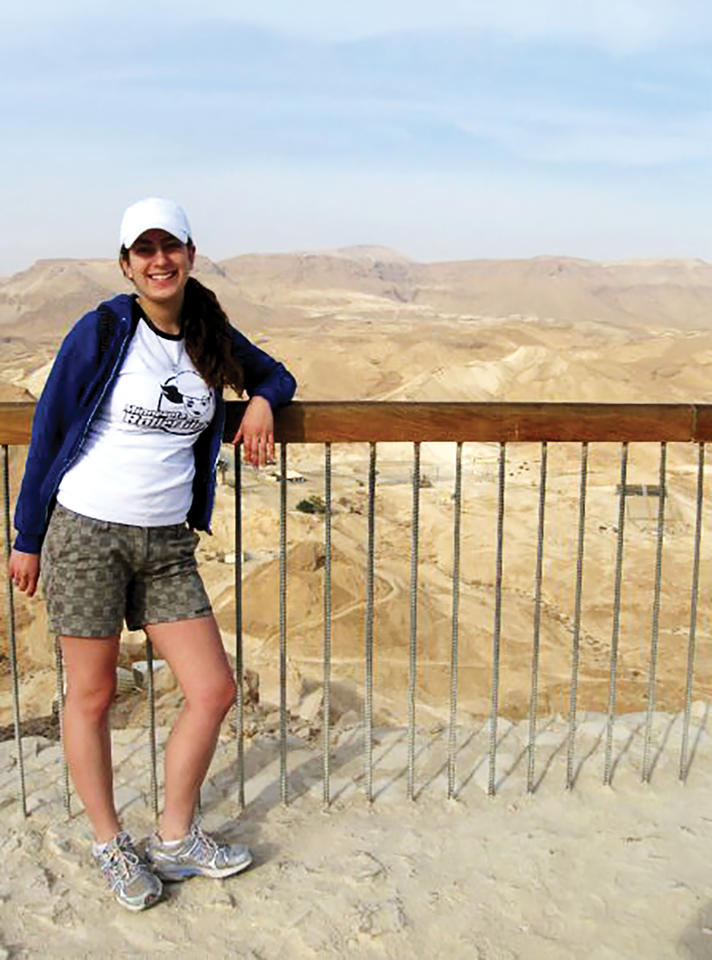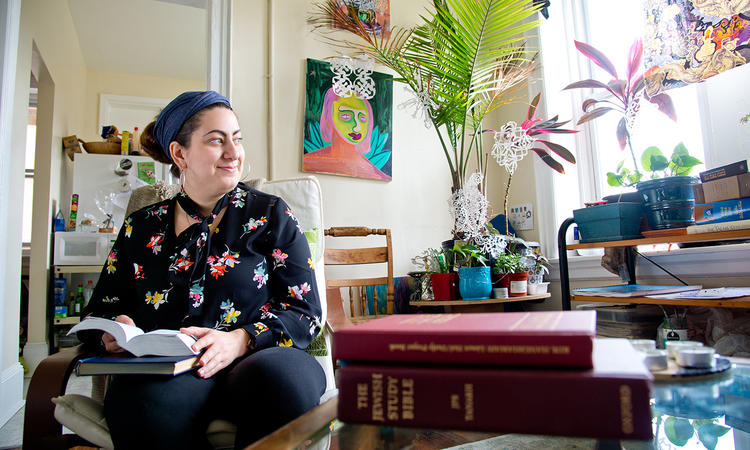By Lornet Turnbull | –
(Yes! Magazine ) – Some are using Birthright trips to draw attention to the Israeli occupation, its policy of oppression, and the call for a two-state solution.
Sarah Brammer-Shlay is a rabbinical student in Philadelphia. She’s also an activist, part of a growing movement of young American Jews working to help ensure that others visiting the Holy Land are prepared to travel there authentically. Photo by Stephanie Holt.
On her first visit to Israel a decade ago, Sarah Brammer-Shlay joined her voice to the prayerful murmurings of the multitude of women, their heads bowed against the ancient stones at Jerusalem’s Western Wall.
In the south, she climbed Masada, King Herod’s desert fortress overlooking the Dead Sea and the site of the last Jewish stronghold against Roman invasion. And she strolled the beaches and hung out with trip mates and new Israeli friends in bars and clubs in Tel Aviv, a spirited city that feels more Florida during spring break than ancient holy place.
For Brammer-Shlay, it was as if her entire childhood—Hebrew school, Jewish youth group, and the stories her parents told her growing up in the Midwest—had been preparation for this Israel trip. “I had been talking about Israel my whole life, like I’d been there, so it was very exciting and powerful to finally actually get there,” she says.
She had known little about the Palestinians there, of their decades-long struggle under Israeli rule.
The trip had been arranged and paid for by Birthright Israel, the world’s largest educational tourism program, which serves 18- to 32-year-old Jews from the diaspora. A rite of passage of sorts for 700,000 young people over the last 20 years, Birthright says the goal is to strengthen their Jewish identity by creating and reinforcing a connection to Israel.
Those 10 days in the summer of 2010 had left Brammer-Shlay wanting to know more. So a little over a year later, on a semester abroad in Jerusalem, she visited the West Bank and began to discover just how much her education on Israel had left out.

Sarah Brammer-Shlay during her Birthright trip in 2010 at the ancient fortress Masada in southern Israel’s Judean Desert. It’s a popular destination and national park. Photo from Sarah Brammer-Shlay.
A rabbinical student in Philadelphia, Brammer-Shlay is an activist now, part of a growing movement of young American Jews working to help ensure that others visiting the Holy Land are prepared to travel there authentically.
From walking off Birthright trips in protest to denouncing what they see as the “omission and erasure of Palestinian narratives,” they are a chorus of new voices bringing fresh attention to the Israeli occupation, its policy of oppression, and the call for a two-state solution.
“What you’re seeing right now is definitely a growing movement of young Jews who are thinking and talking about the occupation and demonstrating that fighting for freedom and dignity for all people is deeply connected with what it means to be Jewish for us,” Brammer-Shlay says.
The size of New Jersey, Israel is a historical and religious marvel—from the beaches of Eilat at the tip of the Red Sea in the south to the picturesque mountain ranges in the north. Sacred to the three Abrahamic religions—Christianity, Judaism, and Islam—it is a destination for people of faith from across the world.
Yet 70 years after Israel’s declaration of statehood displaced some 700,000 Palestinians there—and a half -century after it seized and occupied the West Bank, East Jerusalem, and the Gaza Strip in the Six-Day War—it’s possible for the nearly 4 million visitors each year to overlook much of what decades of conflict have wrought.
So a little over a year later, on a semester abroad in Jerusalem, she visited the West Bank and began to discover just how much her education on Israel had left out.
Israel defends its restrictions on Palestinian movement, the demolition of their homes, the encroaching Jewish settlements and obstructions at every turn by citing a decades-long campaign of cross-border attacks and suicide bombings by Palestinians to drive out Jews.
And that’s what Brammer-Shlay had been told growing up in a conservative Jewish household in Minnesota.
That trip in 2010 was for her what it is for many of the 50,000 Birthright participants each year: the romanticized version of a country they had been hearing about since they were little. On that trip, Brammer-Shlay says, “there was no deep conversation about the impact of the occupation.”
Funded by Israel’s government and global philanthropists, including a substantial contribution by casino mogul and Donald Trump supporter Sheldon Adelson, Birthright in a statement says it was not designed to deal with political issues: “All Birthright Israel participants are required to engage in programming which addresses the complex issues of the Middle East and which does not endorse any specific agendas, opinions, or beliefs.”
For University of Florida doctoral student Madison N. Emas, Birthright wasn’t a search for political answers; it was simply a chance to travel.
She first visited Israel on a mostly religious trip while in high school. On Birthright in 2015, she got to hear from Israeli Arabs with family in the West Bank and East Jerusalem who spoke about their own experiences as well as those of their relatives.
“I didn’t realize how much I didn’t know about the other perspective, about how Israeli Arabs get pulled over more often, about how soldiers could simply just show up at their homes. … I never thought about that before,” she says.
The opportunity to talk to secular Jews, many of whom, like her, support a two-nation solution, “made me feel more Jewish, more connected. … And I think that’s what Birthright is trying to do, foster a connection to the land and the people.”
Last year, in a bold statement about what they felt was the program’s one-sided narrative, Birthright participants began walking off the trip—live-streaming their actions on social media.
Danielle Raskin was among the first.
She had grown up in New York City in a household she describes as culturally, rather than religiously, Jewish. Her agnostic feelings changed, however, in 2016 when she attended a comedy event where some in a Jewish audience cheered for then-candidate Donald Trump. “It was a turning point … Jews who support a fascist,” she says. “It wasn’t an issue thousands of miles away; it was right here.”
She became an organizer for IfNotNow, a progressive and anti-occupation group formed in 2014 to protest Israel’s bombardment of Gaza. Its goal is to address American Jewish support for the occupation and balance the message that young American Jews are getting.
Last summer, Raskin went on a Birthright trip to see for herself.
She did Shabbat in Jerusalem. Rafted the River Jordan. Visited Israel’s northern border with Syria and the Holocaust memorial, Yad Vashem. “They were tightly packed 12-, 13-, 14-hour days,” she says.
She recalls the uncomfortable silence on the trip north as they drove alongside the separation barriers between the Occupied Territories and Israel proper—a system of fences and concrete walls.
“No one said anything; the tour guide said nothing. It was so discreet, I had to open my map app to make sure. I was like, ‘Oh shit, this doesn’t really bode well for the rest of the trip.’”
In addition to questions about the impact of the occupation, she and others asked about maps they were given that they say failed to delineate Palestinian territories.
“It feels like the equivalent of going to the Jim Crow South during segregation and not talking about segregation.”
The maps would become the source of a different confrontation that went viral on a video on social media.
Elon Glickman was six days into his Birthright trip a few months later, driving along the separation barrier between Haifa and Jerusalem when he began asking about them.
The guide, he said in a recent interview, “started telling us that these are normal Jewish villages and that the West Bank is just like [Israeli cities] Tel Aviv or Jerusalem.”
In the video, Glickman protests, “I mean literally, like, erasing the fact that Palestine even exists, though.”
Again and again, he challenges what he said is a one-sided depiction, pointing out that for many participants it’s the only side they’ll see and hear. “It feels like the equivalent of going to the Jim Crow South during segregation and not talking about segregation,” he says.
Eventually other Birthright participants on the bus also join in, some agreeing with him, others reminding him that it is a free trip.
On a video of Raskin’s encounter, a tour guide can be heard accusing her and the others of coming “to bash Israel on purpose and in public and in front of all your friends. … You have a clear agenda against Israel. You tried to impose your opinion for the last 10 days and that’s not acceptable.”
In total, 15 tour goers have walked off their Birthright tours, according to IfNotNow. Three others, it said, were ejected for violating a clause Birthright added in December against “hijacking” discussions on its trips.
In Israel, IfNotNow connected both Glickman and Raskin with Breaking the Silence, an anti-occupation group that helped them round out their trip. While Glickman and his group traveled to the West Bank and stayed with families in villages there, Raskin’s went to Hebron, one of the world’s oldest cities and where the controversial expansion of Jewish settlements has often played out in violent eruptions.
They visited Shuhada Street, a main road there that leads to the Tomb of the Patriarchs, a shrine complex sacred to both Muslims and Jews. Once the scene of a bustling market in Hebron’s historic center, the street is abandoned—its stores shuttered and boarded up. The closure followed the 1994 prayer-time massacre of 29 Palestinians by an Israeli settler. Shuhada, also known as a sterile street, is off limits to Palestinians—whether by car or on foot.
Raskin and her group were shocked by this sight.
“Palestinians whose front doors open out onto the street have to climb out a side window or onto the roof or exit someone else’s house,” she says. “It was really somber, pretty devastating really, to see on the 10th day a side of the country that we had not seen or talked about at all.”
In the months since, other solutions have sprung up. In March, J Street, a progressive group that supports statehood for Palestinians, announced its own free, 10-day trip to Israel and the West Bank for American college students this summer. Participants will visit major heritage sites and meet with Israeli social justice activists and Palestinian community leaders.
Returning home after her own trip to the West Bank in 2011, Brammer-Shlay had searched for ways to address the conflict more meaningfully. She volunteered with the Center for Jewish Nonviolence, in 2016 traveling to Hebron, where she worked alongside Palestinians and other Jews to help build a cinema.
She was back the following year to help reestablish the village of Sarura, in the Hebron Hills, whose residents were returning after fleeing occupation decades earlier. It was part of the largest delegation of diaspora Jews ever assembled for such an action.
These days, Brammer-Shlay works with IfNotNow on a range of actions, including the group’s Not Just a Free Trip campaign, which provides resources to Birthright participants, including at airports just before trips take off.
“I still feel it is my duty to defend the Jewish people,” she says, “but I also feel that is deeply connected to the duty I feel to promote justice and freedom in this world.”
Lornet Turnbull wrote this article for the Travel Issue, the summer 2019 edition of YES! Magazine. Lornet is an editor for YES!, a Seattle-based freelance writer, and a regional anchor for the Washington Post. Follow her on Twitter @TurnbullL.
Reprinted with permission from Yes! Magazine )



 © 2025 All Rights Reserved
© 2025 All Rights Reserved